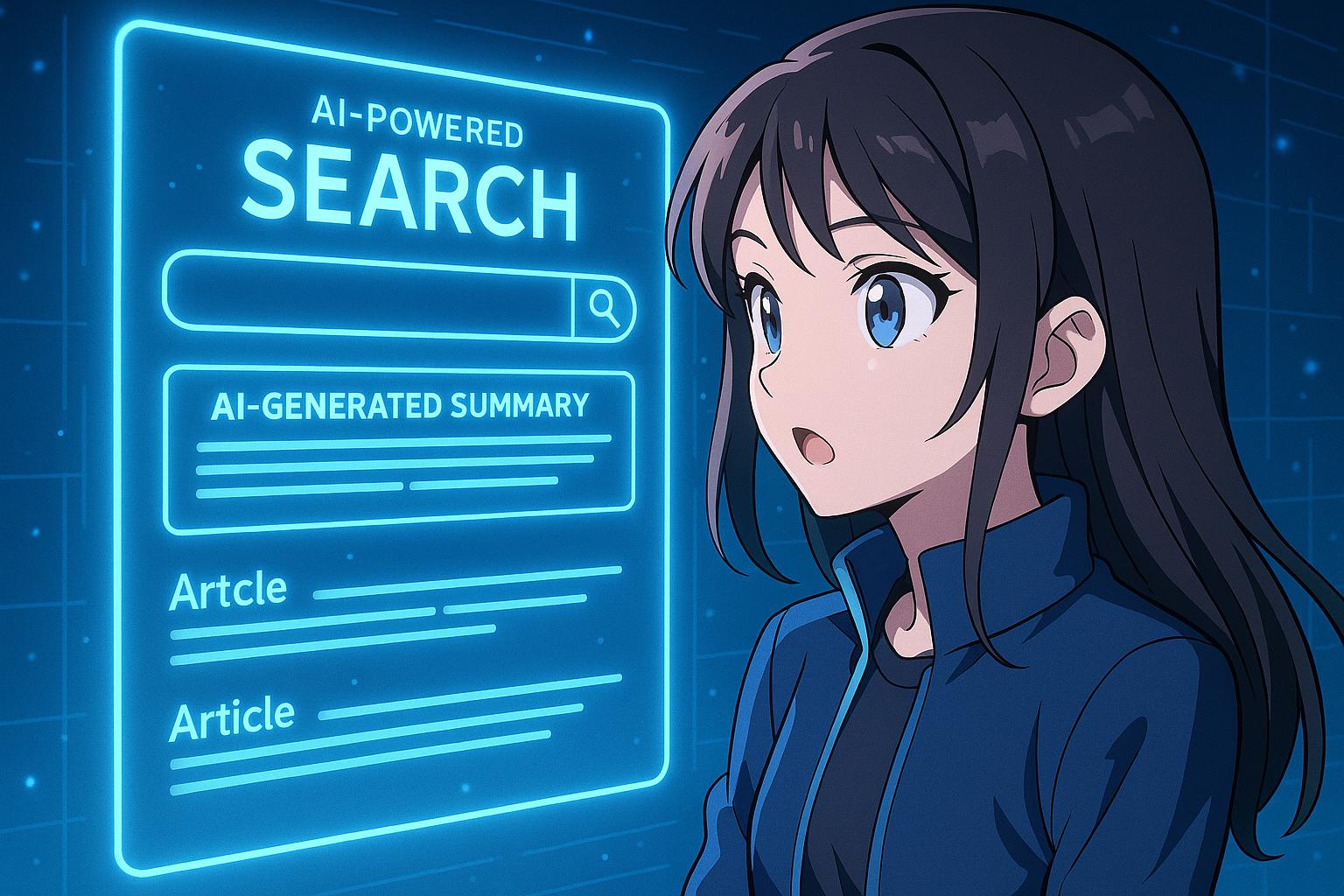Marketers are adjusting paid search campaigns and budgets following a significant drop in clickthrough rates caused by Google’s AI-generated search summaries, which have changed how users interact with search results since their U.S. launch a year ago.
Google’s AI Overviews feature has now marked its first anniversary, representing a significant pivot in the way search engine results are displayed. Launched in the U.S. on May 14 last year, this feature prominently showcases AI-generated summaries above traditional links, fundamentally altering the user’s search experience. As the prevalence of these AI-generated overviews continues to rise, marketers are increasingly reassessing the effectiveness of their strategies aimed at engaging both human users and AI crawlers, raising crucial questions about the implications for search engine optimisation (SEO) and paid search performance.
Since its introduction, AI Overviews have reportedly led to notable decreases in traffic for publisher and brand websites. For instance, clickthrough rates for publishers like Mail Online have plummeted by over 56%, highlighting a stark concern for content-driven businesses. Research from Bain has revealed that 80% of consumers manage to resolve around 40% of their queries without needing to click through from the search results page, a trend that is reshaping the landscape of digital marketing.
In the UK, where AI Overviews have been visible since August 2024, some marketers are starting to observe slight declines in impression share and clickthrough rates for generic, upper-funnel search terms. As Billy Bojku, head of performance media at VML UK, noted, this is a concerning trend his team is monitoring closely, considering the potential shift in consumer behaviour. While nine agency search specialists reported that paid search performance has thus far remained relatively isolated from the adverse impacts seen in organic search, they caution that these changes could affect future advertising strategies.
The types of queries that lead to Overviews being displayed tend to correspond with early-stage information-seeking behaviour, where brands traditionally spend less on advertising. As Katie Tweedy, director of SEO and content marketing at Collective Measures, highlighted, paid search generally targets potential customers further along in the purchasing funnel. Interestingly, despite some clients reporting fewer clicks, Charlie Marchant, CEO of Exposure Ninja, mentioned that these declines haven’t necessarily translated into a drop in sales conversions, allowing brands some room to recalibrate their strategies.
In response to these developments, search agencies are taking proactive measures. Marketers are redirecting budgets, pausing ads that might conflict with organic listings or shifting focus to brand keyword spending, particularly to secure visibility when AI-generated answers reference competitors. Christopher Liversidge, CEO of QueryClick, detailed how this strategy aims to safeguard client interests in a rapidly evolving environment, suggesting that some are reallocating funds previously devoted to broader keywords to ensure they don’t lose valuable traffic.
As search strategies continue to evolve, some agencies are exploring alternative avenues for paid search. For example, many have considered increasing their investment in broad keywords, adapting to the fact that a significant share of their clients’ paid search budgets must reflect current conditions in AI-enhanced search contexts. José de Carvalho, head of paid search at Gain, indicated that U.S. clients observed a 15% to 20% decrease in clickthrough rates since the rollout of AI Overviews, leading to a 10% increase in spending on broad keywords — a strategic pivot meant to address the evolving dynamics.
Moving forward, the landscape of paid advertising on search engines is expected to change further. Observers anticipate that Google will eventually roll out ads within AI Overviews, a move that could significantly impact advertisers’ strategies. Laura Williams, PPC manager at performance agency North, expressed expectations that as Google integrates more paid advertising into these AI-generated summaries, the results will shift, necessitating ongoing adaptation by marketers.
Google’s ongoing experimentation with AI in search also raises broader concerns about traffic and revenue impacts across the entire digital marketing ecosystem. While the company has seen a rise in advertising sales, with a 13% increase to $61.7 billion in the first quarter of the year, the long-term effects of evolving search behaviours and increased competition from AI chatbots, which have rapidly gained traction among users, cannot be ignored. Research indicates that the rise of AI interactions could potentially deplete organic traffic by as much as 25%, challenging traditional models of SEO and necessitating a re-examination of content strategies.
In light of these rapid changes, agencies are being driven to innovate and provide new services that help clients navigate the complexities introduced by AI-enhanced search. Companies such as Exposure Ninja and QueryClick are developing new offerings and tools that focus on understanding and predicting client visibility in AI-driven environments. These proactive measures suggest a potential shift towards a more nuanced approach to digital marketing, where brands remain resilient amid an increasingly AI-centric future.
As these dynamics play out, the emphasis will increasingly need to be on innovative strategies that embrace the dual realities of AI integration and traditional search methodologies, preparing marketers not just to adapt, but to thrive in this swiftly evolving landscape.
Reference Map
- Paragraph 1: [1]
- Paragraph 2: [1], [2]
- Paragraph 3: [1], [2]
- Paragraph 4: [1], [2]
- Paragraph 5: [3], [1]
- Paragraph 6: [1], [4]
- Paragraph 7: [1], [5]
- Paragraph 8: [1], [6], [7]
- Paragraph 9: [1], [4], [7]
Source: Noah Wire Services
- https://digiday.com/marketing/after-a-year-of-googles-ai-overviews-marketers-consider-tweaking-their-paid-search-strategies/ – Please view link – unable to able to access data
- https://apnews.com/article/ebb6bbbde17ed29a5f7b630d9e5e285b – This article discusses Google’s introduction of AI-enhanced search results, which display AI-generated summaries at the top of search queries, potentially reducing web traffic to publisher and brand sites. The feature aims to provide faster information retrieval for complex subjects but raises concerns about decreased click-through rates and revenue losses for publishers. Google assures that traditional links will remain for simpler queries and emphasizes that AI overviews encourage more detailed searches. Legal issues may arise regarding the use of copyrighted material, similar to ongoing litigations against services like OpenAI’s ChatGPT.
- https://www.ft.com/content/decc6853-4fff-448c-b1c3-be8824ab511f – Elizabeth Reid, head of Google Search, discusses the evolution of AI-powered search with the Financial Times. Over the past year, Reid has led the integration of generative AI into search through the launch of AI Overviews, designed to provide better summarized results by retrieving information scattered online. Despite early missteps like inaccurate advice, Google has improved the feature’s accuracy and factual grounding. AI Overviews have led users—especially younger ones—to ask more and longer questions, including multimodal queries (text and images). Google is focused on organizing information efficiently rather than personifying AI as chatbots like ChatGPT do.
- https://www.reuters.com/technology/google-set-bring-ads-search-ai-overviews-2024-05-21/ – Google plans to test search and shopping ads in its AI-generated answers in the U.S., following the feature’s introduction at its recent annual I/O conference. These ads will appear in a ‘sponsored’ section within the AI Overview based on the query’s relevance and information. This move aims to expand its traditional search advertising dominance to the emerging generative AI technology, hoping to increase ad sales, which are crucial to its revenue. In the first quarter ending March 31, Google saw a 13% rise in advertising sales, reaching $61.7 billion. Google is committed to testing new ad formats and gathering feedback from advertisers. At its I/O conference, Alphabet demonstrated its advancements in AI across its businesses, including enhancements to the Gemini chatbot and its search engine.
- https://time.com/6963316/google-charges-users-ai-powered-search-results-report/ – Google is considering monetizing new AI-powered search features by adding them to its premium subscription services, such as the Gemini AI assistant in Gmail and Google Docs. The standard search engine will remain free and continue to feature ads even for subscribers. Google emphasizes its ongoing commitment to enhancing premium offerings but has not confirmed any plans yet. The company has made significant strides in integrating AI into its search capabilities, serving billions of queries with its generative AI experiments. This move comes amidst increased competition from free AI chatbots like OpenAI’s ChatGPT. Google’s AI initiatives include the chatbot Bard, later rebranded as Gemini, and a new trial feature offering AI-generated search results with extended answers for some users in the U.S. and U.K.
- https://www.ft.com/content/9cc6cc0b-759f-4b8e-9ed1-9e32ad0fe22f – As users increasingly turn to AI chatbots like ChatGPT and Claude for information, traditional search engine optimization (SEO) is evolving. Brands and marketing tech companies, such as Profound and Brandtech, are developing tools to monitor and influence how often and positively their names appear in chatbot results. Major brands, including Ramp, Indeed, and Chivas Brothers, have adopted these new tools to stay visible in AI-generated responses. These technologies assess large language models (LLMs) to predict brand sentiment and visibility, offering insights for content adjustments to improve mention rates. This shift threatens Google’s core search business, as Bain research shows 80% of consumers now use AI-generated content for 40% or more of searches, potentially reducing organic traffic by up to 25%. Although Google’s parent, Alphabet, reported a solid 10% revenue increase in Q1 of 2025, the growing popularity of rival AI chatbots remains a long-term concern. Companies like Profound, which recently secured $3.5 million in funding, see the rise of AI as a transformational moment for digital search and marketing, emphasizing content relevance over traditional SEO tactics. Meanwhile, AI search engines like Perplexity are testing new approaches like sponsored follow-up questions to enhance user engagement.
- https://www.emarketer.com/content/google-s-ai-overviews-force-marketers-diversify-search-strategies – This article discusses how Google’s AI Overviews are impacting search strategies. The feature, which provides AI-generated summaries at the top of search results, is altering SEO strategies and the value of organic search results. While AI Overviews could lead to interesting marketing opportunities, their size and prominent placement at the top of results risk devaluing other space on Google’s platform. The article also notes that AI Overviews have forced Google to rearrange elements of the results page, with sponsored results appearing further down the page after publishers and Reddit threads. The layout of results pages can vary significantly, even for identical queries, highlighting how sponsored search results are no longer guaranteed to instantly put an ad in front of consumers.
Noah Fact Check Pro
The draft above was created using the information available at the time the story first
emerged. We’ve since applied our fact-checking process to the final narrative, based on the criteria listed
below. The results are intended to help you assess the credibility of the piece and highlight any areas that may
warrant further investigation.
Freshness check
Score:
8
Notes:
The narrative references Google’s AI Overviews introduced about a year ago, which is a relatively recent development. However, specific figures like Google’s advertising sales and the impact on organic traffic could be considered recent data, though their exact timelines are not provided.
Quotes check
Score:
6
Notes:
Direct quotes are provided from industry specialists, but without online sources to verify their earliest known references. This could indicate original quotes or they might have been published elsewhere prior.
Source reliability
Score:
8
Notes:
The narrative originates from Digiday, a reputable source in the marketing industry, suggesting a high level of reliability. However, the article’s claims about Google’s strategies and their impact on marketing do not provide specific primary sources.
Plausability check
Score:
8
Notes:
The claims about the impact of AI Overviews on search strategies seem plausible given the context of evolving digital marketing trends. However, specific figures like clickthrough rate decreases and consumer behaviours are not verified with primary sources.
Overall assessment
Verdict (FAIL, OPEN, PASS): PASS
Confidence (LOW, MEDIUM, HIGH): HIGH
Summary:
The narrative appears to be a recent and relevant discussion on Google’s AI Overviews and their impact on marketing strategies. The reliability of the source is high, and the plausibility of the claims aligns with current digital marketing trends. However, some figures and quotes lack primary sources for verification.













